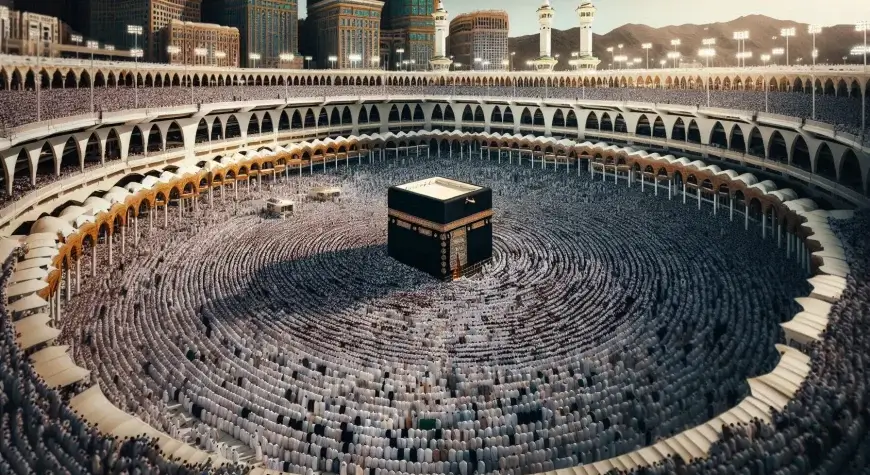Guidance about Stages of Hajj

Hajj, one of the Five Pillars of Islam, holds a significant place in the lives of Muslims. This annual pilgrimage to the holy city of Makkah is a profound spiritual journey that aims to cleanse the soul, foster humility, and strengthen the bond with Allah. There are different types of Hajj – Tamattu’, Ifraad, and Qiran. This comprehensive guide will focus on Tamattu’, the most common type of Hajj performed by pilgrims.
Hajj is not merely a physical journey; it’s a profound spiritual experience that brings together millions of Muslims from around the world, uniting them in their faith and devotion. This guide will walk you through the stages of Hajj, from preparation to the final rites, providing essential tips and insights to ensure your journey is fulfilling and meaningful.
Preparing for Hajj
Making the Intention (Niyyah)
Before embarking on Hajj, it’s crucial to purify one’s heart and make a sincere intention (Niyyah). The intention is not just a formal declaration; it’s a heartfelt commitment to perform Hajj solely for the sake of Allah. This spiritual resolve sets the tone for the journey ahead, ensuring that every action is done with the consciousness of Allah’s presence.
Types of Intentions:
- Hajj: The intention to perform the pilgrimage.
- Umrah: The intention to perform the lesser pilgrimage, which can be done anytime outside the Hajj season.
- Hajj and Umrah: The combined intention to perform both during the Hajj season (Tamattu’).
Entering the State of Ihram
Ihram is a sacred state a pilgrim must enter before performing Hajj or Umrah. It involves specific rituals, including wearing the prescribed attire and abstaining from certain actions.
Steps to Enter Ihram:
- Ghusl (Ritual Bath): Perform a full-body purification.
- Wearing Ihram Garments: Men wear two white, unstitched pieces of cloth, while women wear modest clothing.
- Reciting Talbiyah: Proclaiming the intent by reciting, “Labbayka Allahumma Labbayk” (Here I am, O Allah, here I am).
Spiritual Significance: Ihram signifies a state of purity and devotion, reminding pilgrims of their equality before Allah and their commitment to leave behind worldly concerns.
The Initial Rites in Makkah
Performing Tawaf
Tawaf, the act of circumambulating the Kaaba seven times, is one of the most iconic rituals of Hajj. Pilgrims start from the Black Stone, moving in a counter-clockwise direction, expressing their submission to Allah.
Etiquette and Supplications:
- Start at the Black Stone: Touch or point towards it if possible.
- Recite Duas: Personal prayers and supplications can be made throughout the Tawaf.
- Maintain Humility: Focus on the spiritual significance, reflecting on the unity and oneness of Allah.
Sa’i between Safa and Marwa
Sa’i commemorates Hagar’s (AS) search for water for her son, Ismail (AS). Pilgrims walk back and forth seven times between the hills of Safa and Marwa, symbolizing perseverance and trust in Allah’s provision.
Historical Significance: This ritual reflects the struggle and faith of Hagar, reminding pilgrims of the importance of patience and reliance on Allah in times of hardship.
The Days in Mina
The 8th of Dhul-Hijjah (Tarwiyah Day)
On the 8th of Dhul-Hijjah, known as Tarwiyah Day, pilgrims travel to Mina, where they spend the day in prayer and contemplation.
Rituals in Mina:
- Setting Up Camp: Pilgrims stay in tents, preparing mentally and spiritually for the journey ahead.
- Performing Prayers: Engage in the five daily prayers, focusing on their intentions and seeking Allah’s guidance.
The 9th of Dhul-Hijjah (Day of Arafah)
The Day of Arafah is the pinnacle of Hajj. Pilgrims gather on the plains of Arafat, standing in earnest supplication from noon until sunset.
Significance of Arafah:
- Forgiveness: It’s a time to seek Allah’s forgiveness, reflecting on one’s life and resolving to improve.
- Unity: The gathering at Arafat symbolizes the unity of the Muslim Ummah, standing together in worship and humility.
The Rites in Muzdalifah
Collecting Pebbles
After sunset on the Day of Arafah, pilgrims move to Muzdalifah. Here, they collect pebbles for the stoning ritual.

Purpose and Procedure:
- Following the Sunnah: Collecting 49 to 70 pebbles, adhering to the Prophet Muhammad’s (PBUH) example.
- Engaging in Worship: Spend the night in prayer and rest, preparing for the stoning ritual in Mina.
The Days in Mina (Continued)
The 10th of Dhul-Hijjah (Eid al-Adha)
Eid al-Adha, the Festival of Sacrifice, commemorates Prophet Ibrahim’s (AS) willingness to sacrifice his son in obedience to Allah.
- Qurbani: Sacrifice an animal, reflecting Ibrahim’s devotion and Allah’s mercy.
- Shaving or Trimming Hair: Men shave their heads or trim their hair, while women cut a small portion of their hair.
Stoning the Jamarat (Ramy al-Jamarat)
Pilgrims participate in the stoning of the Jamarat, throwing pebbles at three pillars representing Satan.
Symbolism:
- Rejecting Evil: This act signifies rejecting temptation and reaffirming one’s commitment to follow Allah’s path.
Tawaf al-Ifadah
Tawaf al-Ifadah, performed after the stoning ritual, is a crucial part of Hajj.
Significance:
- Renewal: It symbolizes a renewed dedication to Allah, performed after the major rites of Hajj.
The Farewell Tawaf
Tawaf al-Wida (Farewell Circumambulation)
The final act of Hajj is the Tawaf al-Wida, a farewell circumambulation of the Kaaba.
Emotional and Spiritual Significance:
- Bidding Farewell: It’s a poignant moment, marking the end of the spiritual journey.
- Gratitude and Reflection: Pilgrims reflect on their experiences, expressing gratitude to Allah for the opportunity to perform Hajj.
Additional Tips for Hajj
Physical and Mental Preparation
Hajj is a physically demanding journey. Ensure you are in good health and prepared for the challenges.
Advice:
- Fitness: Engage in regular exercise to build stamina.
- Health Checkups: Address any medical conditions and ensure vaccinations are up-to-date.
- Mental Preparation: Cultivate patience and resilience.
Logistics and Practicalities
Proper planning is essential for a smooth Hajj experience.
Key Considerations:
- Visas and Documentation: Ensure all necessary documents are in order.
- Accommodation: Book early to secure convenient lodging.
- Packing Essentials: Bring comfortable clothing, toiletries, and necessary medications.
Spiritual Preparation
Enhance your understanding of Hajj rituals and their significance.
Recommendations:
- Seek Knowledge: Study the rituals and their meanings.
- Engage in Worship: Increase acts of worship, such as prayer and recitation of the Quran.
- Seek Forgiveness: Make sincere repentance and seek Allah’s forgiveness.
Etiquette during Hajj
Maintain a positive and respectful attitude throughout your journey.
Guidelines:
- Patience: Expect challenges and remain patient.
- Kindness: Treat fellow pilgrims with respect and compassion.
- Focus on Worship: Avoid conflicts and distractions, concentrating on the spiritual aspects of Hajj.

Conclusion
The journey of Hajj is a transformative experience that deepens one’s faith and fosters a closer connection with Allah. By understanding and following the stages of Hajj, pilgrims can ensure a fulfilling and spiritually enriching journey. May Allah accept your Hajj and grant you a safe and blessed pilgrimage.
FAQs
1. What are the different types of Hajj?
- Tamattu’, Ifraad, and Qiran.
2. What is the significance of Ihram?
- Ihram signifies a state of purity and devotion, preparing pilgrims for the sacred rituals of Hajj.
3. Why is the Day of Arafah important?
- It is the pinnacle of Hajj, a time for seeking forgiveness and standing in earnest supplication before Allah.
4. What is the purpose of the stoning ritual?
- The stoning of the Jamarat symbolizes rejecting evil and reaffirming one’s commitment to Allah.
5. How can I prepare physically and mentally for Hajj?
- Engage in regular exercise, ensure health checkups, and cultivate patience and resilience.
By following this comprehensive guide, you can embark on the journey of a lifetime with confidence and devotion, making your Hajj a truly transformative and spiritually fulfilling experience.

